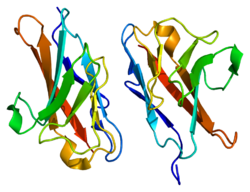CD66a
| Carcinoembryonic antigen-related cell adhesion molecule 1 | ||
|---|---|---|

|
||
| according to PDB 2GK2 | ||
| other names |
Biliary glycoprotein 1 |
|
| Properties of human protein | ||
| Mass / length primary structure | 526 amino acids , 57,560 Da | |
| Identifier | ||
| External IDs | ||
| Orthologue (human) | ||
| Entrez | 634 | |
| Ensemble | ENSG00000079385 | |
| UniProt | P13688 | |
| Refseq (mRNA) | NM_001024912.2 | |
| Refseq (protein) | NP_001020083.1 | |
| PubMed search |
634
|
|
Carcinoembryonic antigen-related cell adhesion molecule 1 (synonym CEACAM1 , CD66a ) is a surface protein and cell adhesion molecule from the immunoglobulin superfamily .
properties
CD66a is one of twelve representatives of CEACAM. It is formed in several isoforms in endothelial cells , epithelial cells , granulocytes, and lymphocytes , of which those with a long cytosolic fraction are the most common. Isoform 1 is involved in cell adhesion , angiogenesis, and the inhibition of the immune response . The immune response is inhibited by cell contact with other cells and an inhibition of the degranulation of cytotoxic T cells , an inhibition of NK cells by binding to other CD66a and an inhibition of the formation of interleukin-1beta in neutrophils . It is glycosylated and phosphorylated .
CD66a binds to PTPN11 and Annexin A2 .
CD66a is involved in the development of melanoma . The ratio of the isoforms CEACAM1-S / CEACAM1-L is a prognostic marker in non-small cell lung cancer .
Web links
Individual evidence
- ↑ N. Beauchemin, A. Arabzadeh: Carcinoembryonic antigen-related cell adhesion molecules (CEACAMs) in cancer progression and metastasis. In: Cancer metastasis reviews. Volume 32, Number 3-4, December 2013, pp. 643-671, doi : 10.1007 / s10555-013-9444-6 , PMID 23903773 .
- ^ Z. Chen, L. Chen, SW Qiao, T. Nagaishi, RS Blumberg: Carcinoembryonic antigen-related cell adhesion molecule 1 inhibits proximal TCR signaling by targeting ZAP-70. In: Journal of Immunology. Volume 180, Number 9, May 2008, pp. 6085-6093, PMID 18424730 .
- ↑ Huber M, Izzi L, Grondin P, Houde C, Kunath T, Veillette A, Beauchemin N: The carboxyl-terminal region of biliary glycoprotein controls its tyrosine phosphorylation and association with protein-tyrosine phosphatases SHP-1 and SHP-2 in epithelial cells . In: The Journal of Biological Chemistry . 274, No. 1, January 1999, pp. 335-44. doi : 10.1074 / jbc.274.1.335 . PMID 9867848 .
- ↑ Kirshner J, Schumann D, Shively JE: CEACAM1, a cell-cell adhesion molecule, directly associates with annexin II in a three-dimensional model of mammary morphogenesis . In: The Journal of Biological Chemistry . 278, No. 50, December 2003, pp. 50338-45. doi : 10.1074 / jbc.M309115200 . PMID 14522961 .
- ↑ G. Turcu, RI Nedelcu, DA Ion, A. Brînzea, MD Cioplea, LB Jilaveanu, SA Zurac: CEACAM1: Expression and Role in Melanocyte Transformation. In: Disease markers. Volume 2016, 2016, p. 9406319, doi : 10.1155 / 2016/9406319 , PMID 27642217 , PMC 5013198 (free full text).
- ↑ Y. Ling, J. Wang, L. Wang, J. Hou, P. Qian, W. Xiang-dong: Roles of CEACAM1 in cell communication and signaling of lung cancer and other diseases. In: Cancer metastasis reviews. Volume 34, Number 2, June 2015, pp. 347-357, doi : 10.1007 / s10555-015-9569-x , PMID 26081722 .